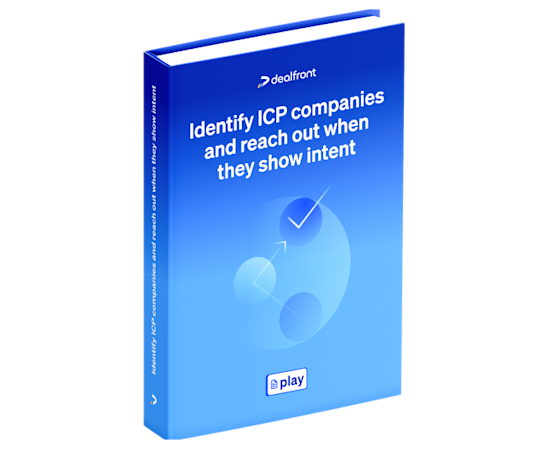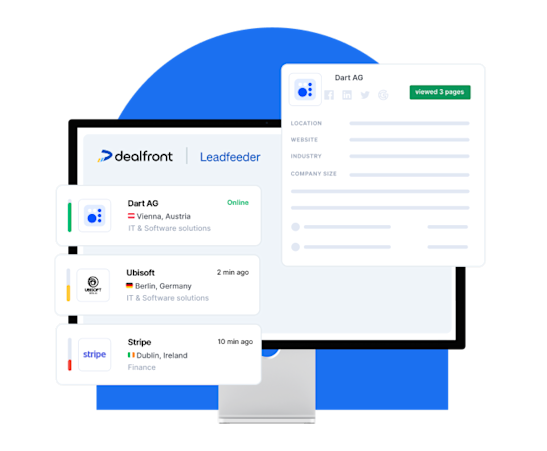60-Second Summary
B2B intent data helps uncover the interests, challenges, and online behaviors of your potential customers, enabling smarter decisions across marketing and sales. This guide explores how to effectively collect, interpret, and act on intent signals to drive conversions, improve targeting, and stay ahead of competitors.
Intent data enhances B2B strategies: Tailor campaigns, align teams, and improve conversion rates by using intent signals tied to customer interests, keyword searches, and competitor activity.
Maximize both first- and third-party data: Leverage onsite behaviors, social interactions, and external search signals to identify buyer intent at every funnel stage.
Frameworks for activation: Apply intent data for lead scoring, sales enablement, customer retention, and hyper-personalized content and ad strategies.
Avoid common missteps: The included checklist covers frequent buyer intent data pitfalls, so you can capitalize on signals without wasting your budget or efforts.
With B2B buyer intent data, you can gain insights into your target audience's needs and preferences, from what topics pique their interest to the challenges they aim to overcome.
This guide will give you everything you need to start your journey with B2B intent data. Understand the process, its benefits, and the essential tools for successful implementation. Plus, at the end of the article, we’ve included our comprehensive checklist of the most common mistakes made when buying intent data so that you can safely avoid them.
Let’s begin with the fundamentals and take it one step at a time.
What is B2B intent data?
Intent data is information that reveals the online behavior of prospects, indicating their potential interest in buying a product or service. The data includes actions like website visits, content downloads, keyword searches, and social media interactions.
In B2B marketing and sales, intent data is commonly used to identify the buyer intent of prospects.
Buyer intent is the likelihood of a potential customer purchasing a product based on their actions indicating readiness to buy.
The role of intent data in sales and B2B marketing
Intent data signals have become increasingly crucial in today’s sales and marketing landscape due to two primary reasons:
- 1.
The surge in popularity of account-based marketing (ABM): ABM revolves around pinpointing specific high-value accounts with the greatest potential for conversion. This strategy necessitates an in-depth understanding of target accounts, encompassing their business needs, pain points, and purchasing capacity. Intent data facilitates the acquisition of these insights, enabling tailored outreach efforts.
- 2.
The escalating demand for inbound marketing: Inbound marketing centers on attracting initial visitors and cultivating their loyalty. This entails providing solutions to their online queries and addressing their concerns. Intent data aids in comprehending the content preferences of your target audience, empowering you to generate more of the content they find compelling.
What are the benefits of B2B intent data?
Intent data revolutionizes B2B sales and marketing by pinpointing what potential customers seek, allowing tailored strategies. It aligns marketing and sales teams with customer behavior, enhancing efficiency and driving higher conversions with shorter sales cycles.
There are several reasons why B2B companies should use intent data:
- 1.
Increased conversion rates: Companies that focus their sales and marketing efforts on leads that have demonstrated buyer intent are more likely to experience higher conversion rates.
- 2.
Better customer retention: By understanding your existing customers' evolving needs, you can proactively engage with them, offering relevant upgrades or complementary solutions. This not only strengthens your relationship with existing clients but also maximizes each customer's lifetime value.
- 3.
Optimized marketing budget: Companies can optimize their marketing budgets by concentrating marketing efforts on prospects actively expressing interest, improving the return on investment (ROI).
- 4.
Competitive advantage: Proactively responding to buyer intent can give your company a competitive advantage, allowing it to stay ahead of the competition.
- 5.
Alignment of sales and marketing teams: Intent data aligns sales and marketing teams by enabling better lead prioritization and fostering a common understanding of customer needs, ensuring more effective collaboration and resource allocation.
Intent data types
To harness customer intent, it’s crucial to grasp the types and sources of intent data. It broadly falls into two types of intent data: first-party and third-party intent data.
First-party intent data
First-party intent data is data companies collect themselves, for example, from their website, email, and other online platforms. It provides information about how users interact with the company's content, what pages they visit, and what actions they take.
Second-party intent data
Second-party intent data is less common than first-party and third-party intent data. This data is gathered by partner companies and shared through intent partners or other agreements.
Third-party intent data
Third-party intent data is collected by external sources and provides insights into prospects' online activities on other websites and platforms.
If you're looking to buy third-party data, make sure to pick a provider that is GDPR-compliant. Also, pay attention to the quality, timeliness, and traceability of the data's origin.
Now, let's break down how to identify buyer intent using first-party and third-party intent data.
Four types of intent data sources
Now, let’s examine the four main types of intent data sources businesses use and how they work.
Type | How it works |
|---|---|
Search intent data | Search intent data, collected from search engine queries, reveals topics of interest to your audience. For instance, if you offer sales intelligence software, you can target companies searching for "How to simplify prospecting?" This helps you anticipate customer needs and outpace competitors. |
Engagement data | Engagement data tracks interactions with your content from sources like blogs and social media. Dark social, for example, involves sharing content through platforms that are hard to track, such as Facebook Messenger. This data helps tailor content or pursue sales leads. |
Firmographic data | Firmographic data includes company details like size, location, and industry sourced from directories and B2B data providers. Integrating firmographics with ABM allows targeted outreach to high-converting companies. |
Technographic data | Technographic data details a company's tech infrastructure. Use surveys to understand their needs. For instance, if you sell B2B data, identify if they use outdated systems. This helps offer relevant solutions. |
How to identify buyer intent through first-party intent data
You can use your first-party intent data collected from your own channels and platforms to identify the likelihood of a prospect making a purchase. Here are five indicators of buyer intent in prospects collected from first-party intent data:
- 1.
They consume your content: For example, by reading an article on your blog or downloading an ebook on your website. You can measure page visits and time spent on the page to understand which content is most popular.
- 2.
They visit your product or pricing page: If a prospect visits your product or pricing page, it's a clear sign of interest in understanding your product or service better to make a purchase decision.
- 3.
They visit your profile or interact with your posts on social media: Social media platforms like LinkedIn allow you to see when prospects show interest in you or your products and services. Keep an eye on the interactions on your own profile and company page.
- 4.
They attend your webinar or event: Prospects often attend webinars or events to get a better impression of a company's products or services without obligation.
- 5.
They subscribe to your newsletter: Your newsletter subscribers can be potential customers or current customers who are open to upselling. Measure opening rate and clicks for more insights into B2B buying intent.
How to identify buyer intent through third-party intent data
Next up is the data collected outside of your own channels and platforms. Now, this is when it gets really interesting!
Let's break down three indicators of buyer intent in prospects collected from third-party intent data:
- 1.
They visit review platforms: B2B companies often compare tools on review platforms, such as Capterra or G2, to see what other users think of a product or service. Does this mean that you can get information about which prospects are comparing your offer to your competitors? Yes, that's exactly what it means!
- 2.
They visit your competitors' websites: Wouldn't it be interesting to know who's visiting them? Of course, it would be! There's a big chance that prospects visiting your competitor's websites are looking for a product or service you provide – making them your target audience. You can also prevent churn by checking if your customers are checking out competitors' websites. If they do, you can reach out to them in time and do what you can to prevent them from leaving. Great! How do I get my hands on this data? You might ask. There are several different tools you can use to access third-party data. We'll cover the details of this further down!
- 3.
They search for the solution you're offering: Third-party intent data lets you identify users searching for keywords related to your product or service. These are what we call buyer intent keywords.
Let's dive into that real quick before we move on to how B2B companies can use intent data to increase growth.
What are buyer intent keywords?
Buyer intent keywords are words or phrases that indicate an intention to buy a product or service; prospects use them when searching on Google (and other search engines).
By tracking the volume of buyer intent keywords, you can better understand the demand for your product or service. By accessing third-party intent data, you can also discover which prospects are searching for specific keywords.
Implement these keywords in your SEO strategy and create content that draws potential customers (with buyer intent) to your website organically.
Buyer intent keywords can be organized into three categories based on where the prospect is in the customer journey:
- 1.
Keywords in the research process (informational keywords) In the first category of buyer intent keywords, prospects are searching for questions like 'what,' 'who,' 'where,' and 'how'. These keywords signal a low purchase intention since the prospects are most likely at the beginning of the customer journey. Examples of words and phrases in this category are 'How do I get more B2B leads?' and 'What is outbound sales?'. If you want to rank for these keywords, create informational content in a guide format, providing the reader with valuable tips.
- 2.
Keywords in the decision-making process (navigational keywords) Prospects using navigational keywords are looking specifically for a product or service to buy. At this point, they are diligently comparing offerings and searching for things like 'Tools for B2B lead gen' and 'Tool A vs. Tool B'. Content for this category can be customer case studies and comparison guides, something that emphasizes the unique benefits of your product. Promoting free trials is also common in this phase of the customer journey.
- 3.
Keywords in the buying process (transactional keywords) In the last phase, transactional keywords signal a specific buyer intent. Here, prospects often search for 'the best way to buy Tool A' or 'Discount for Tool B. This is where you go all in and use your content to promote offers for your product or service.
That was that; now, let's discuss using intent data for B2B marketing and sales efforts!
How to use intent data: Five ways all companies can (and should) harness B2B marketing intent data
Data should inform business decisions, and B2B intent data offers a Pandora’s Box of actionable insights. Whether refining product offerings or creating compelling content, informed and strategic decisions are made possible.
Here are five strategies for leveraging intent data for B2B marketing:
- 1.
Customer retention and up-selling: Intent data isn't just for acquiring new customers; it can also be valuable for retaining and upselling existing customers. Monitor the online behavior of your current clients to identify signs of potential upsell opportunities or indications that they may be considering additional products or services.
- 2.
Lead scoring and prioritization: Integrate intent data into your lead scoring to identify and prioritize leads that are showing a high level of interest or engagement. This allows your sales team to focus their efforts on prospects more likely to convert, improving efficiency and maximizing the impact of your sales activities.
- 3.
Personalized content marketing: Leverage intent data to inform your content marketing strategy. Develop content that aligns with the topics your target audience is actively searching for. This could include creating blog posts, whitepapers, webinars, or other resources that address their current concerns or challenges.
- 4.
Targeted advertising campaigns: Use intent data to create more targeted and personalized advertising campaigns. By understanding the specific topics or products prospects are actively researching, you can tailor your ads to their current needs and interests. This can increase the effectiveness of your advertising efforts and improve the chances of conversion.
- 5.
Sales Enablement: Provide your sales team with intent data to enhance their conversations with prospects. Knowing the specific interests and pain points of a lead allows sales representatives to tailor their pitches and provide more targeted solutions. This can lead to more meaningful interactions, increased customer satisfaction, and higher conversion rates.
Our favorite B2B intent data providers
Ready to start collecting and using customer intent data?
When you’re looking for a B2B intent data provider to help you collect the best consumer intent data, there are a lot of platforms and tools available. To give you some guidance, we have selected a few of our favorite data intent tools and divided them into two categories: tools for buyer intent keywords and tools to identify website visitors:
Tools for buyer intent keywords
Wondering which websites your target audience is visiting and what terms they are searching for? DemandJump will give you the answers.
When it comes to keyword research, there are a lot of great free tools out there. We like AnswerthePublic, Thruuu, Keyword Too, and the kwfinder.
Tools to identify website visitors
When users visit your website, it's usually a sign that they're interested in what you offer. You can use the following tools to identify otherwise anonymous website visitors and (if they're a good fit) nurture them into customers:
Leadfeeder by Dealfront (works with Google Analytics)
Last but not least, you can use the comparison platform G2 to reveal prospects who are comparing your offer (or a competitor's).
Stay on top of B2B intent data for true business growth
Neglecting intent data means overlooking valuable insights into your target audience, potentially forfeiting numerous sales opportunities.
Using intent data isn't merely a tactic; it's a pivotal game-changer for B2B enterprises aiming to maintain a competitive edge in their industry. Insights gleaned from intent data pave the way for personalized marketing, precise sales initiatives, and strategic decision-making.
Mastering intent data is key to unlocking fresh opportunities, nurturing robust customer connections, and ultimately establishing a sustainable competitive edge!
Identify and land your dream customers with Dealfront. Try it for free today!
B2B intent data FAQs
How is B2B intent data collected?
B2B buyer intent data is collected by monitoring, logging, and aggregating online activity. This can include pages visited, content downloaded, search queries, and more.
Is intent data only for B2B?
Despite being used more frequently by B2B businesses, intent data is not exclusively useful for these organizations. A good example of a B2C business harnessing the power of buyer intent data is Amazon’s use of browsing and buying histories to provide recommendations.
What’s the difference between intent data and relationship data?
Intent data tracks and records online behaviours that can be used to identify potential customers.
In contrast, relationship data keeps a record of the interactions between potential customers and businesses.
While intent and relationship data can definitely complement one another, use of intent data would typically come before the use of relationship data in the sales funnel.



